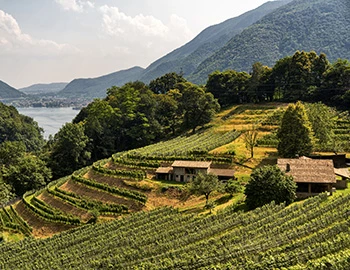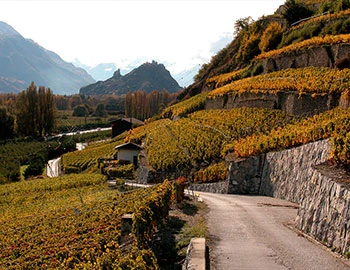
Merlot Rovere, Limited Edition Stiftung Synapsis, 2021
DOC Ticino, Cantina Monti, 750 ml

| Grape variety: | Merlot |
| Producer: | Cantina Monti |
| Origin: | Switzerland / Tessin / Sottoceneri |
Description
A limited special edition to mark the 20th anniversary of Dementia Research Switzerland. In memoriam Sergio Monti, co-founder of the Foundation Synapsis Switzerland. The Merlot Rovere is produced from the best vineyards of the Sottoceneri. The strict grape selection in the vineyard and low yields, as well as the optimum ripeness, produced a Ticino Merlot that is variety typical in the nose with herbaceous notes that are followed by dark, ripe cherries and plums. On the palate it is full-bodied, precise and well-structured with soft, fine-grained tannins. Monti created a great balance of fruit, skilful use of barrique and extract. The wine convinces with a long finish on the palate characterized by dark fruit aftertaste. Decant the wine for maximum enjoyment!
Attributes
| Origin: | Switzerland / Tessin / Sottoceneri |
| Grape variety: | Merlot |
| Ripening potential: | 4 to 10 years after harvest |
| Drinking temperature: | 16 to 18 °C |
| Food Pairing: | Rabbit ragout with olives, Saltimbocca, Scaloppine di vitello al limone, Mussels au gratin, Spaghetti carbonara, Risotto with ceps |
| Vinification: | long must fermentation, fermentation in steel tank, fining |
| Harvest: | hand-picking |
| Maturation: | in large wooden barrel/foudre, short cultivation |
| Bottling: | filtration |
| Maturation duration: | 12 months |
| Volume: | 13.5 % |
| Note: | Contains sulphites |
Cantina Monti
Located at 550 meters above sea level, with extreme slopes, the Cantina Monti covers 4.7 hectares. The sloping soil does not allow mechanization in the vines, which includes nine different grape varieties. Every season, the Monti family immediately focuses on the production of superior quality wines, a quality also given by the very low yield in the vineyard.
For Cantina Monti, discipline and respect for the harvest are the keys to the success of the vintage. This means protecting nature and embracing the methods of Integrated Production in order to minimize interventions in the vineyard. The time of harvesting is essential, and must take place at the right time. For this reason, at the Cantina Monti several harvests are carried out, depending on the vine in question. Even in the cellar there are rules: the less the product is scrambled, the more the integrity of the wine itself is guaranteed insuring a taste created by nature.

Cantina Monti
Located at 550 meters above sea level, with extreme slopes, the Cantina Monti covers 4.7 hectares. The sloping soil does not allow mechanization in the vines, which includes nine different grape varieties. Every season, the Monti family immediately focuses on the production of superior quality wines, a quality also given by the very low yield in the vineyard.
For Cantina Monti, discipline and respect for the harvest are the keys to the success of the vintage. This means protecting nature and embracing the methods of Integrated Production in order to minimize interventions in the vineyard. The time of harvesting is essential, and must take place at the right time. For this reason, at the Cantina Monti several harvests are carried out, depending on the vine in question. Even in the cellar there are rules: the less the product is scrambled, the more the integrity of the wine itself is guaranteed insuring a taste created by nature.

Merlot
Everybody’s darling
Merlot is the most charming member of the Bordeaux family. It shines with rich colour, fragrant fullness, velvety tannins and sweet, plummy fruit. It even makes itself easy for the vintner, as it matures without issue in cool years as well. This is in contrast to the stricter Cabernet Sauvignon, which it complements as a blending partner. Its good qualities have made the Merlot famous worldwide. At over 100,000 hectares, it is the most-planted grape in France. It also covers large areas in California, Italy, Australia and recently in Eastern Europe. The only catch is that pure Merlot varieties rarely turn out well. Its charm is often associated with a lack of substance. Only the best specimens improve with maturity. They then develop complex notes of leather and truffles. This succeeds in the top wines from the Bordeaux appellation of Pomerol and those from Ticino, among others.

Merlot
Everybody’s darling
Merlot is the most charming member of the Bordeaux family. It shines with rich colour, fragrant fullness, velvety tannins and sweet, plummy fruit. It even makes itself easy for the vintner, as it matures without issue in cool years as well. This is in contrast to the stricter Cabernet Sauvignon, which it complements as a blending partner. Its good qualities have made the Merlot famous worldwide. At over 100,000 hectares, it is the most-planted grape in France. It also covers large areas in California, Italy, Australia and recently in Eastern Europe. The only catch is that pure Merlot varieties rarely turn out well. Its charm is often associated with a lack of substance. Only the best specimens improve with maturity. They then develop complex notes of leather and truffles. This succeeds in the top wines from the Bordeaux appellation of Pomerol and those from Ticino, among others.

Tessin
Ticino: the Merlot Mecca of Switzerland
Ticino winegrowing is thought to date from Roman times, as early as 2000 years ago. But the foundation for today’s viticulture was laid just over 100 years ago, in 1907. It was then that the first Merlot vines were planted at Castelrotto in Malcantone. Since then, the variety has emerged triumphant here. Top selections matured in barriques more than measure up to those from Bordeaux’s Saint-Émilion or Pomerol regions.

Switzerland
Switzerland – A small country with enormous diversity
Switzerland is famous for its banks, watches, and cheese, but not necessarily for its wine. The Swiss didn't invent wine, but they have been extremely open and curious to it. Wine culture arrived in what is now modern Switzerland via several routes: from Marseilles to Lake Geneva and the Lower Valais region; from the Aosta Valley through the Great St. Bernard Pass to the rest of Valais; from the Rhone through Burgundy, across the Jura Mountains to Lake Constance; and from Lombardy to Ticino, and then on to Grisons.


